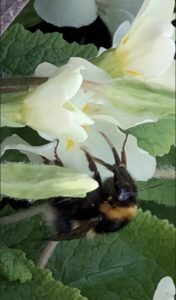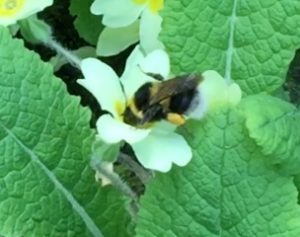Primroses. A good nectar source for early pollinators?
Many articles I have read over the years state that primroses are a useful nectar source for early pollinating bumblebees. Well, in fact, if we look a little closer, it depends upon their tube-like proboscis or tongue size as we shall see.
Hungry Bombus terrestris queen
Today 8th April, perhaps the best weather day of the year around here, whilst in the garden, I saw a huge queen B. terrestris landing, well almost crashing really, onto the ground next to several primrose clumps. She crawled to one clump of flowers and with her tongue extended put her head right inside a primrose corolla (Primula vulgaris), moved on to the next flower and then another, each time her tongue extended. She half flew half scrambled to the next clump and tried a couple more flowers. Had a short rest, then flew off. Not wasting my time on them she thought!

A long tongue is needed to feed on primroses.
Bumblebee feeding depends on tongue size
Prof. Dave Goulson, states in The best garden flower for bees,“Many flowers are attractive to bees, with different types of bee varying in their particular preferences. In particular, long-tongued bumblebees such as Bombus hortorum tend to favour deep flowers, and of course, short-tongued bumblebees such as Bombus terrestris prefer shallow flowers. Sometimes short-tongued bees rob deep flowers by biting a hole in the side of the flower so they can reach the nectar”.
Short-tongued B. terrestris
B. terrestris has a short tongue. I do not think this queen was successful at feeding. She was too heavy and rather clumsy as she handled the primrose flowers, to make a success of her foraging. The flowers simply bent under her weight unable to support her sufficiently for her to forage. I thought she may bite a hole in the flower corolla and commit a little ‘nectar robbing’ but she did n’t. Perhaps queens don’t do this? although B. terrestris workers are known for this practice, esp. runner bees. Once workers have chewed a hole in the corolla tubes, honey bees who cannot chew such holes, take advantage of the ‘nectar robbers’ handiwork! I got the impression this queen was hungry and tried to feed and realised she could n’t so off she went. She either had not learnt or seen an example of how to ‘nectar rob’ or was simply not equipped with the toothed mandibles required to chew or perforate through to the nectar, unlike B.terrestris workers who manage to do it. This particular bee was just too large to handle and perhaps not equipped to forage on the primrose flowers. I also saw a B. hypnorum land on the primrose flowers but did not see whether she fed on them or not.
Long-tongued B. hortorum success!
The same evening I filmed this B. hortorum feeding on many primrose flowers, crawling from flower to flower, tongue extended. And what a tongue! She has a longer and thinner face, compared to the more circular faces of other bumblebees. Her face shape helps her to delve deeper into longer corollas. She did not have any pollen in her baskets so I am assuming she had not started a nest just yet, unlike the queen B. hortorum below. So to answer my question, yes they are for B. hortorum bumblebees!

Foraging queen with a pollen load
Bee flies
Unlike B. terrestris, Bee flies have a very long straight proboscis. They are seen regularly feeding on primroses. Unlike bumblebees who place their head inside the actual flower, these flies can often collect nectar as they hover over the food plant, place their long legs and feet upon the petals and feeding using their proboscis.
Don’t forget to plant for bumblebee queens
Although the flowers mentioned from the list above are used by bumblebees, although many of them are used by workers in the summer months. It is also important to plant specifically for bumblebee queens as without them you will not have any bumblebee workers. See the film, Bumblebee queens need the right flowers.
“All my articles and videos, available free, are funded by my teaching and sales of award-winning bumblebee nest boxes, solitary bee boxes, bird feeders and wormeries. Please help by spreading the word and forwarding this link to your friends and colleagues. https://nurturing-nature.co.uk Thank you” George Pilkington
Recommended reading and further information
“Plants for bees: A guide to the plants that benefit the bees of the British Isles” by W.D.J. Kirk and F.N. Howes.- An excellent updated book, covers wild and honey bees, with lavish photographs, written by experts.
“Garden Plants valuable to bees” by International Bee Research Association – much cheaper, essentially a plant list, written by experts, no photographs!
Join this group of scientists and non-scientists, adults and children to help find out more about bees and our other pollinators!
For more information about the new Buzz Club in association with the University of Sussex
For an excellent bee fly, ID chart click here by the Soldierflies and Allies Recording Scheme
For more information and to help save bumblebees join the Bumblebee Conservation Trust

Recent Comments